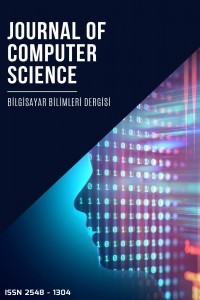A Novel Covid-19 Detection System Based on PSO and Hybrid Feature Using Support Vector Machines
Koronavirüs, Özellik Seçimi, LBP, DenseNet, SVM
A Novel Covid-19 Detection System Based on PSO and Hybrid Feature Using Support Vector Machines
Covid-19, Feature Selection, LBP, DenseNet, SVM,
___
- Clerc, M. (2010). Particle Swarm Optimization. Particle Swarm Optimization, 1942–1948. https://doi.org/10.1002/9780470612163
- Cohen, J. P., Morrison, P., Dao, L., Roth, K., Duong, T. Q., & Ghassemi, M. (2020). COVID-19 Image Data Collection: Prospective Predictions Are the Future. http://arxiv.org/abs/2006.11988
- Cortes, C., & Vapnik, V. (1995). Support-vector networks. Machine Learning, 20(3), 273–297. https://doi.org/10.1007/BF00994018
- COVID-19 Radiography Database | Kaggle. (n.d.). Retrieved April 14, 2021, from https://www.kaggle.com/tawsifurrahman/covid19-radiography-database
- Cucinotta, D., & Vanelli, M. (2020). WHO declares COVID-19 a pandemic. Acta Biomedica, 91(1), 157–160. https://doi.org/10.23750/abm.v91i1.9397
- Göreke, V., Sarı, V., & Kockanat, S. (2021). A novel classifier architecture based on deep neural network for COVID-19 detection using laboratory findings. Applied Soft Computing, 106, 107329. https://doi.org/10.1016/j.asoc.2021.107329
- Guan, W., Ni, Z., Hu, Y., Liang, W., Ou, C., He, J., Liu, L., Shan, H., Lei, C., Hui, D. S. C., Du, B., Li, L., Zeng, G., Yuen, K.-Y., Chen, R., Tang, C., Wang, T., Chen, P., Xiang, J., … Zhong, N. (2020). Clinical Characteristics of Coronavirus Disease 2019 in China. New England Journal of Medicine, 382(18), 1708–1720. https://doi.org/10.1056/nejmoa2002032
- Hanbay, D. (2009). An expert system based on least square support vector machines for diagnosis of the valvular heart disease. Expert Systems with Applications, 36(3 PART 1), 4232–4238. https://doi.org/10.1016/j.eswa.2008.04.010
- Huang, C., Wang, Y., Li, X., Ren, L., Zhao, J., Hu, Y., Zhang, L., Fan, G., Xu, J., Gu, X., Cheng, Z., Yu, T., Xia, J., Wei, Y., Wu, W., Xie, X., Yin, W., Li, H., Liu, M., … Cao, B. (2020). Clinical features of patients infected with 2019 novel coronavirus in Wuhan, China. The Lancet, 395(10223), 497–506. https://doi.org/10.1016/S0140-6736(20)30183-5
- Huang, G., Liu, Z., Van Der Maaten, L., & Weinberger, K. Q. (2017). Densely connected convolutional networks. Proceedings - 30th IEEE Conference on Computer Vision and Pattern Recognition, CVPR 2017, 2017-Janua, 2261–2269. https://doi.org/10.1109/CVPR.2017.243
- Irvin, J., Rajpurkar, P., Ko, M., Yu, Y., Ciurea-Ilcus, S., Chute, C., Marklund, H., Haghgoo, B., Ball, R., Shpanskaya, K., Seekins, J., Mong, D. A., Halabi, S. S., Sandberg, J. K., Jones, R., Larson, D. B., Langlotz, C. P., Patel, B. N., Lungren, M. P., & Ng, A. Y. (2019). CheXpert: A Large Chest Radiograph Dataset with Uncertainty Labels and Expert Comparison. http://arxiv.org/abs/1901.07031
- Ismael, A. M., & Şengür, A. (2021). Deep learning approaches for COVID-19 detection based on chest X-ray images. Expert Systems with Applications, 164(March 2020). https://doi.org/10.1016/j.eswa.2020.114054
- Karakanis, S., & Leontidis, G. (2021). Lightweight deep learning models for detecting COVID-19 from chest X-ray images. Computers in Biology and Medicine, 130(November 2020), 104181. https://doi.org/10.1016/j.compbiomed.2020.104181
- Ojala, T., Pietikäinen, M., & Harwood, D. (1996). A comparative study of texture measures with classification based on feature distributions. Pattern Recognition, 29(1), 51–59. https://doi.org/10.1016/0031-3203(95)00067-4
- Ojala, T., Pietikäinen, M., & Mäenpää, T. (2002). Multiresolution gray-scale and rotation invariant texture classification with local binary patterns. IEEE Transactions on Pattern Analysis and Machine Intelligence, 24(7), 971–987. https://doi.org/10.1109/TPAMI.2002.1017623
- Varela-Santos, S., & Melin, P. (2021). A new approach for classifying coronavirus COVID-19 based on its manifestation on chest X-rays using texture features and neural networks. Information Sciences, 545, 403–414. https://doi.org/10.1016/j.ins.2020.09.041
- Wu, X., Chen, C., Zhong, M., Wang, J., & Shi, J. (2021). COVID-AL: The diagnosis of COVID-19 with deep active learning. Medical Image Analysis, 68, 101913. https://doi.org/10.1016/j.media.2020.101913
- ISSN: 2548-1304
- Yayın Aralığı: Yılda 2 Sayı
- Başlangıç: 2016
- Yayıncı: Ali KARCI
IoT Botnet Verisetlerinin Karşılaştırmalı Analizi
Akciğer Kanser Tipi Tespitinde Etkili Bir Görüntü Çoğullama Tekniği
Berna ARI, Ömer Faruk ALÇİN, Abdülkadir ŞENGÜR
Classification of Skin Cancer with Deep Transfer Learning Method
Doaa Khalid Abdulridha AL-SAEDİ, Serkan SAVAŞ
Novel Machine Learning (ML) Algorithms to Classify IPv6 Network Traffic in Resource-Limited Systems
Yıldıran YILMAZ, Selim BUYRUKOĞLU, Muzaffer ALIM
Akademik Yazılarda Resim İntihal Kontrolü Sistemi
Muhammed Saadetdin KAYA, Kenan İNCE
IPS Sistemlerde Yapay Zekânın Son Beş Yıldaki Gelişimi
EMG Sinyallerinin HFD Analizi ve Hareket Sınıflandırılması
Gazi AKGÜN, Uğur DEMİR, Alper YILDIRIM
Derin Öğrenme Tabanlı Görüntü İşleme İle Acil Durum Tespiti
